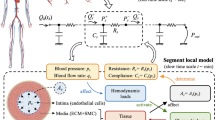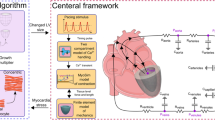Abstract
Mechanical stimuli play critical roles in cardiovascular diseases, in which in vivo stresses in blood vessels present a great challenge to predict. Based on the structural–thermal coupled finite element method, we propose a thermal expansion method to estimate stresses in multi-layer blood vessels under healthy and pathological conditions. The proposed method provides a relatively simple and convenient means to predict reliable in vivo mechanical stresses with accurate residual stress. The method is first verified with the opening-up process and the pressure-radius responses for single and multi-layer vessel models. It is then applied to study the stress variation in a human carotid artery at different hypertension stages and in a plaque of vascular stenosis. Our results show that specific or optimal residual stresses exist for different blood pressures, which helps form a homogeneous stress distribution across vessel walls. High elastic shear stress is identified on the shoulder of the plaque, which contributes to the tearing effect in plaque rupture. The present study indicates that the proposed numerical method is a capable and efficient in vivo stress evaluation of patient-specific blood vessels for clinical purposes.








Similar content being viewed by others
References
Humphrey, J.D.: Vascular adaptation and mechanical homeostasis at tissue, cellular, and sub-cellular levels. Cell Biochem. Biophys. 50, 53–78 (2008)
Wang, G.L., Wang, L.Y., Yang, S.X., et al.: Arterial wall remodeling under sustained axial twisting in rats. J. Biomech. 60, 124–133 (2017)
Cyron, C.J., Humphrey, J.D.: Growth and remodeling of load-bearing biological soft tissues. Meccanica 52, 645–664 (2017)
Humphrey, J.D.: Cardiovascular Solid Mechanics: Cells, Tissues, and Organs. Springer, New York (2002)
Chuong, C.J., Fung, Y.C.: Three-dimensional stress distribution in arteries. J. Biomech. Eng. 105, 268–274 (1983)
Han, H.C., Fung, Y.C.: Direct measurement of transverse residual strains in aorta. Am. J. Physiol. 270, H750–H759 (1996)
Delfino, A., Stergiopulos, N., Moore, J.E., et al.: Residual strain effects on the stress field in a thick wall finite element model of the human carotid bifurcation. J. Biomech. 30, 777–786 (1997)
Gasser, T.C., Schulze-Bauer, C.A.J., Holzapfel, G.A.: A three-dimensional finite element model for arterial clamping. J. Biomech. Eng. 124, 355–363 (2002)
Ohayon, J., Dubreuil, O., Tracqui, P., et al.: Influence of residual stress/strain on the biomechanical stability of vulnerable coronary plaques: potential impact for evaluating the risk of plaque rupture. Am. J. Physiol. Circ. Physiol. 293, H1987–H1996 (2007)
Fereidoonnezhad, B., Naghdabadi, R., Holzapfel, G.A.: Stress softening and permanent deformation in human aortas: continuum and computational modeling with application to arterial clamping. J. Mech. Behav. Biomed. Mater. 61, 600–616 (2016)
Polzer, S., Bursa, J., Gasser, T.C., et al.: A numerical implementation to predict residual strains from the homogeneous stress hypothesis with application to abdominal aortic aneurysms. Ann. Biomed. Eng. 41, 1516–1527 (2013)
Fung, Y.C.: What are the residual stresses doing in our blood vessels? Ann. Biomed. Eng. 19, 237–249 (1991)
Weisbecker, H., Pierce, D.M., Holzapfel, G.A.: A generalized prestressing algorithm for finite element simulations of preloaded geometries with application to the aorta. Int. J. Numer. Methods Biomed. Eng. 30, 857–72 (2014)
Pierce, D.M., Fastl, T.E., Rodriguez-Vila, B., et al.: A method for incorporating three-dimensional residual stretches/stresses into patient-specific finite element simulations of arteries. J. Mech. Behav. Biomed. Mater. 47, 147–164 (2015)
Holzapfel, G.A., Mulvihill, J.J., Cunnane, E.M., et al.: Computational approaches for analyzing the mechanics of atherosclerotic plaques: a review. J. Biomech. 47, 859–869 (2014)
Holzapfel, G.A., Gasser, T.C., Ogden, R.W.: A new constitutive framework for arterial wall mechanics and a comparative study of material models. J. Elast. 61, 1–48 (2000)
Ross, R.: The pathogenesis of atherosclerosis: a perspective for the 1990s. Nature 362, 801–809 (1993)
Gimbrone, M.A., García-Cardeña, G.: Endothelial cell dysfunction and the pathobiology of atherosclerosis. Circ. Res. 118, 620–636 (2016)
Barrett, H.E., Cunnane, E.M., Kavanagh, E.G., et al.: On the effect of calcification volume and configuration on the mechanical behaviour of carotid plaque tissue. J. Mech. Behav. Biomed. Mater. 56, 45–56 (2016)
Cunnane, E.M., Mulvihill, J.J.E., Barrett, H.E., et al.: Mechanical properties and composition of carotid and femoral atherosclerotic plaques: a comparative study. J. Biomech. 49, 3697–3704 (2016)
Demiray, H.: A note on the elasticity of soft biological tissues. J. Biomech. 5, 309–311 (1972)
Lubarda, V.A.: Constitutive theories based on the multiplicative decomposition of deformation gradient: thermoelasticity, elastoplasticity, and biomechanics. Appl. Mech. Rev. 57, 95–108 (2004)
Holzapfel, G.A., Sommer, G., Auer, M., et al.: Layer-specific 3D residual deformations of human aortas with non-atherosclerotic intimal thickening. Ann. Biomed. Eng. 35, 530–545 (2007)
Chobanian, A.V., Bakris, G.L., Black, H.R., et al.: Seventh report of the Joint National Committee on prevention, detection, evaluation, and treatment of high blood pressure. J. Am. Heart Assoc. 42, 1206–1252 (2003)
Fung, Y.C., Liu, S.Q.: Change of residual strains in arteries due to hypertrophy caused by aortic constriction. Circ. Res. 65, 1340–1349 (1989)
Barrett, S.R.H., Sutcliffe, M.P.F., Howarth, S., et al.: Experimental measurement of the mechanical properties of carotid atherothrombotic plaque fibrous cap. J. Biomech. 42, 1650–1655 (2009)
Li, Z.Y., Howarth, S., Trivedi, R.A., et al.: Stress analysis of carotid plaque rupture based on in vivo high resolution MRI. J. Biomech. 39, 2611–2622 (2006)
Acknowledgements
The authors would like to thank Prof. Shu Takagi and Prof. Huaxiong Huang for their instructive comments. The authors would also like to acknowledge Jianda Yang for assisting with FEM simulations. This work was supported by the National Natural Science Foundation of China (Grants 11372191, 11232010, 11650410650, 11550110185). The authors would like to acknowledge the support from the Tianjin Special Lecturer (Grant 91111138), and the National Institute of Health (Grant 2R01DC005642-10A1).
Author information
Authors and Affiliations
Corresponding author
Rights and permissions
About this article
Cite this article
Yang, S., Zhang, L.T., Hua, C. et al. A prediction of in vivo mechanical stresses in blood vessels using thermal expansion method and its application to hypertension and vascular stenosis. Acta Mech. Sin. 34, 1156–1166 (2018). https://doi.org/10.1007/s10409-018-0780-1
Received:
Revised:
Accepted:
Published:
Issue Date:
DOI: https://doi.org/10.1007/s10409-018-0780-1




